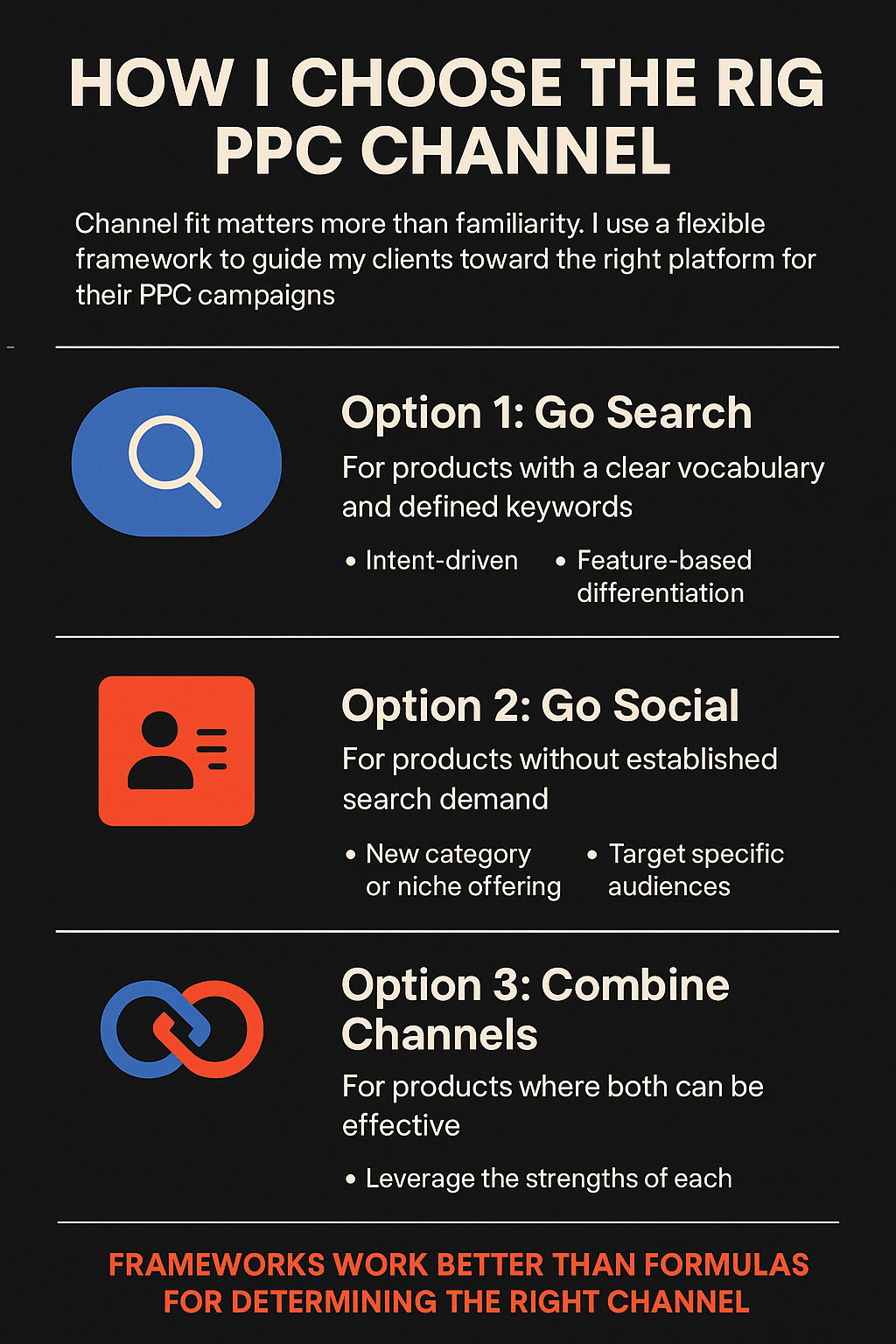When it comes to paid advertising, the first question many marketers ask is: Which PPC channel or platform should we use?
For a lot of businesses, the answer feels obvious—Google Ads or LinkedIn Ads. These are popular, proven platforms that dominate the PPC world. And I get it. Most prospects who reach out to me already have one in mind. In fact, Google Ads tends to be the default, especially for B2B and SaaS brands. Lately, I’ve seen more interest in LinkedIn Ads, too.
But here’s the thing: the best channel isn’t the one you’ve heard the most about.
The best channel is the one that aligns with how your audience thinks, searches, and makes buying decisions. And that’s not always as simple as it seems.
Why PPC Channel Fit Matters More Than Channel Familiarity
Choosing the wrong channel doesn’t just waste budget—it creates false negatives. You might try a platform, get weak results, and assume the PPC channel “doesn’t work.” When in reality, the issue wasn’t your creative, budget, or product—it was that you were showing up in the wrong place at the wrong time.
That’s why I use a flexible framework to guide my clients toward the right channel (or combination of channels) based on the nature of their offering and how their buyers behave.
Here’s how I think about it.

The Framework: Search vs. Social vs. Both
There are three main routes when planning a PPC campaign:
- Search-first strategy (e.g., Google or Bing Ads)
- Audience-first strategy (e.g., LinkedIn, Meta, programmatic)
- Hybrid strategy (a mix of both, optimized to support each other)
The channel decision depends heavily on how the product or service fits into the buyer’s mindset.
👉 Option 1: Go Search When There’s Clear Demand and Defined Keywords
If your product has a well-established vocabulary—meaning people already know what to search for—you can win big with paid search.
Let’s say you sell project management software or B2B compliance solutions. Your audience might be searching for:
- “Best project management software for remote teams”
- “HIPAA compliance software for healthcare”
In cases like this, you have direct search demand. People are actively looking for something you offer, using keywords that align closely with your product’s core features and use cases. That’s a green light for Google Ads.
Search works well when:
- There’s a clear pain point people are already trying to solve
- Your category is mature with high intent queries
- Your product has feature-based differentiation
It’s also easier to track ROI through conversions because searchers tend to be closer to purchase.
👉 Option 2: Go Social When Demand Needs to Be Created
Now, flip the scenario.
Imagine you sell an emerging tech solution or a niche B2B product. Something innovative, or maybe something that serves a problem people don’t even realize they have yet.
In this case, there’s no good keyword for what you’re offering. If no one knows your category exists, they won’t be searching for it. That’s where paid social platforms like LinkedIn or Meta shine.
Here, the goal is interruption with value. You’re putting the right message in front of the right person based on who they are—not what they’re searching for.
For example, if you offer AI-powered procurement tools for logistics managers, it’s unlikely that people are typing “AI for procurement” into Google every day. But on LinkedIn, you can target job titles like “Supply Chain Director” and introduce them to your solution before they go searching.
Audience-based strategies are best when:
- The product category is new or under-known
- The buying audience is highly defined (e.g., job titles, industries)
- You need to generate demand through awareness and education
👉 Option 3: Combine Channels When It Makes Sense
Some brands fall right in the middle. Maybe they offer a known solution with new positioning. Or maybe they target multiple buyer groups with different behaviors.
In these cases, a hybrid approach is best.
Search captures people already looking. Social builds awareness and warms up future searchers.
Here’s a simple example of how this works in practice:
- You use LinkedIn Ads to run top-of-funnel content (e.g., “Why your finance team struggles with forecasting”)
- Those who click get added to a retargeting pool and start seeing additional content and offers
- Some of them later search for a related term—like “financial forecasting software”
- Now they’re met with your Google Search ad and they recognize your brand
This kind of flywheel effect is powerful—and when done right, it dramatically lowers your overall cost per acquisition.
Why Frameworks > Formulas
I’ve had clients come to me adamant about running Google Ads—only to discover that their product lacked search volume or that the keywords were all too broad.
Others thought LinkedIn would be “too expensive,” but once we layered on job title targeting and offered the right asset, their cost-per-lead was lower than expected.
That’s why I always go back to the framework.
Not every product is suited for every channel. But every product has an ideal path to customer awareness—and your job is to figure out what that path looks like.
Frameworks like this help you think strategically instead of reactively. They make your campaigns smarter, more efficient, and ultimately, more successful.
Final Thoughts
There’s no single “best” advertising channel. There’s only the best channel for your audience, your offer, and your goals.
So before you launch your next PPC channel campaign, ask yourself:
- Does my audience know they need my product?
- Are there high-intent keywords they’re already searching?
- Or do I need to educate, inspire, and introduce the problem first?
Answer those, and you’ll have your channel strategy.
If you’re unsure, start with testing—but do it with intention. A small budget, the right message, and a clear offer can teach you more in 30 days than a dozen whitepapers ever will.
Don’t default to what’s popular.
Default to what works—for your buyers.

Hi there! I’m Scott, and I am the principal consultant and thought leader behind Stratus Analytics. I have a Master of Science degree in marketing analytics, and I’ve have been providing freelance digital marketing services for over 20 years. Additionally, I have written several books on marketing which you can find here on Amazon or this website.
DISCLAIMER: Due to my work in the packaging industry, I cannot take on freelance clients within the packaging manufacturing space. I do not want to provide disservice to your vision or my employer. Thank you for understanding.
